2005.05.05 11:08
Koolhaas versus the Actor
...just did a very quick scan of l'architecture dans le boudoir, and it seems a very good reference point, and a very good point of departure for further investigation regarding architecture and reenactment. (Thanks very much for making the contribution.) Now, taking l'architecture dans le boudoir and the non-Tafuri reading of the Campo Marzio plan may indeed deliver heretofore unexpected fruitful results in terms of understanding all the mid-late 20th architecture that Tafuri writes about.
Now I have to thoroughly re-read the essay, plus go through the A+U on De Feo in Quondam's collection, plus look closely at the Designs for the Bicentennial by Venturi and Rauch, plus republish those "Stirling's Legacy" essays that used to be at Quondam, and who knows what else.
| |
2014.01.19 19:25
19 January
Since its arrival on Friday, I've been spot-reading from ANY 25/26: Being Manfredo Tafuri (2000). Very early this morning I read Kurt Forster's "No Escape from History, No Reprieve from Utopia, No Nothing: An addio to the anxious historian Manfredo Tafuri," and one passage peaked my interest:
"Apart from Aldo Rossi and Carlo Aymonino, Tafuri proposed Vittorio De Feo's buildings and projects as "among the most remarkable of recent Italian work." What he gave in praise with one hand, he withdrew (dialectically) with the other, when he cautioned that "neither De Feo nor Manieri-Elia are able to link their choice of reference code to a suitable act of engagement." The projects and buildings of De Feo that Tafuri chose to illustrate are mostly megastructures resembling nothing so much as the contemporary American projects of a Kevin Roche or, later Arquitectonica."
I found it very odd that Forster relates the work of De Feo to that of Kevin Roche and (later) Arquitectonica, as he seems to have completely missed the connection of De Feo's work to that of The Philadelphia School. In any case, I now have to see exactly what it was that Tafuri wrote about De Feo:
"In writing about De Feo, Francesco Dal Co speaks of a "suspended architecture." And in fact, the works of De Feo--among the most remarkable of recent Italian work--oscillate between the creation of entirely virtual spaces and typological research at the level of the organism. The experimentation with the deformation of geometric elements is predominant, as seen in the project for the new House of Representatives in Rome, planned with the Stass group (1967); the Technical School at Terni (1968-74); and the competition for an Esso service station (1971). Here, De Feo treats geometry as a primary element, to be juxtaposed with the chosen functional order. Compared to the purism of Rossi, the architecture of De Feo, or for that matter of Georgio Ciucci and Mario Manieri-Elia, appears more empirical and casual. However, within its search for the pure and the intrinsic qualities of form, it possesses qualities at once self-critical and self-ironic, which are revealed as a disenchanted pop image (and wherein the exasperated geometric play of the Esso station is resolved). It is possible here to find a warning: once the "form is made free;" the geometric universe becomes an uncontrollable "adventure."* Without doubt, similar studies are historically born upon reflections on themes introduced by Kahn; yet, for Italians in particular, each study of linguistic tools loses the mystic aura and simple faith in the charismatic power of institutions. We are therefore faced with an apparent paradox. Those who concentrate on linguistic experimentation have lost the old illusions about the innovative powers of communication. Yet by accepting the relative independence of syntactic research, we are then confronted with the arbitrary qualities of the reference code. Thus neither De Feo nor Manieri-Elia are able to link their choice of reference code to a suitable act of engagement (which in itself may have other means of self-expression)."
Manfredo Tafuri, "L'Architecture dans le Boudoir: The language of criticism and the criticism of language") in Oppositions 3 (1974), pp. 46-48.
And the images presented along with this text are:
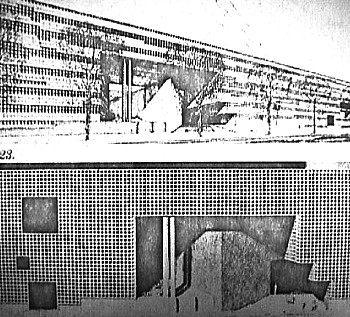
Regional offices competition, Trieste. Vittorio De Feo and Associates, architects, 1974.
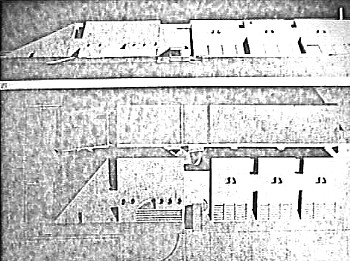
Technical school, Terni. Vittorio De Feo and Errico Ascione, architects, 1968-74.
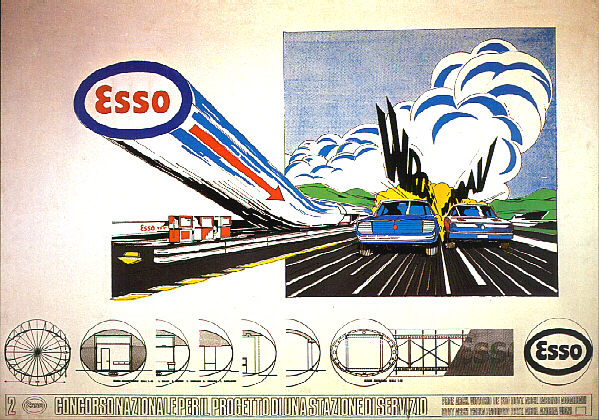
Esso Service Station, project, Vittorio De Feo and Associates, 1971.
| |
The Technical school, in particuler, owes a debt to Mitchell/Giurgola's Acadia National Park Headquarters Building (1965),
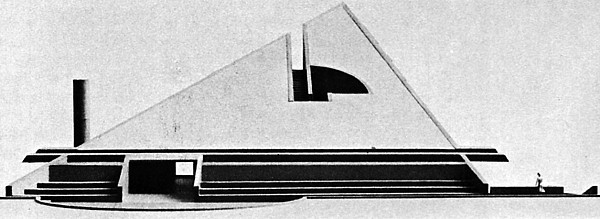
which, in turn, owes a debt to Kahn and Noguchi's Levy Memorial Playground (1963) and Kahn's Council of Islamic Ideology (1965).
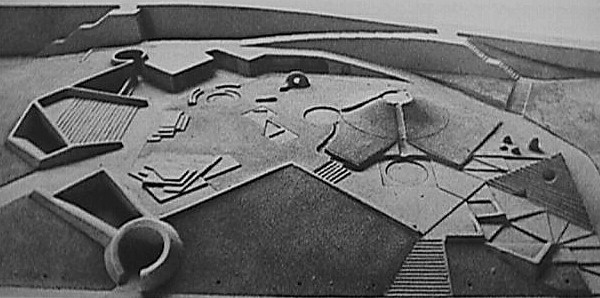
Mitchell/Giurgola's Acadia National Park Headquarters Building was featured within (the Italian publication) Zodiac 17 (September 1967),
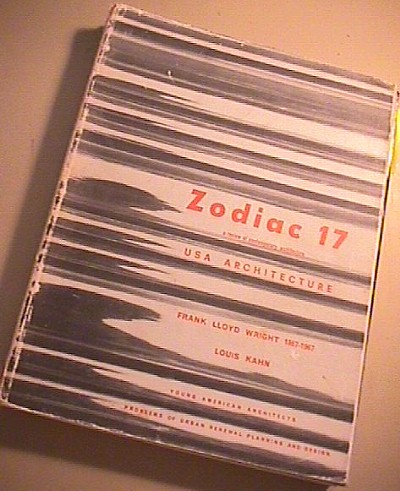
where the section drawing of the Acadia National Park Headquarters Building
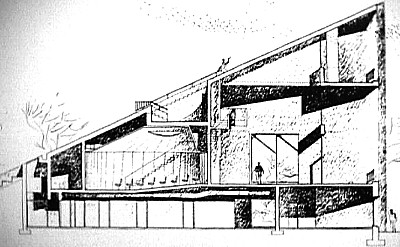
bears a striking resemblence to a section drawing De Feo's new House of Representatives in Rome [actually the New Office Building for the Chamber of Deputies of the Italian Parliament], 1967.
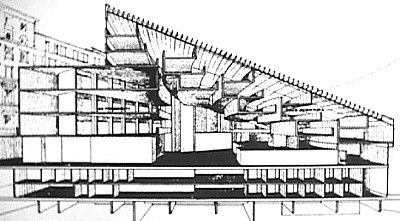
|